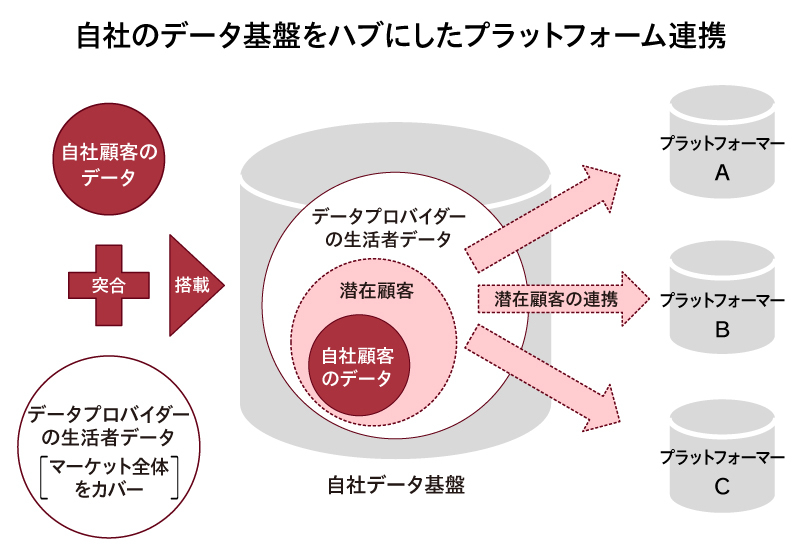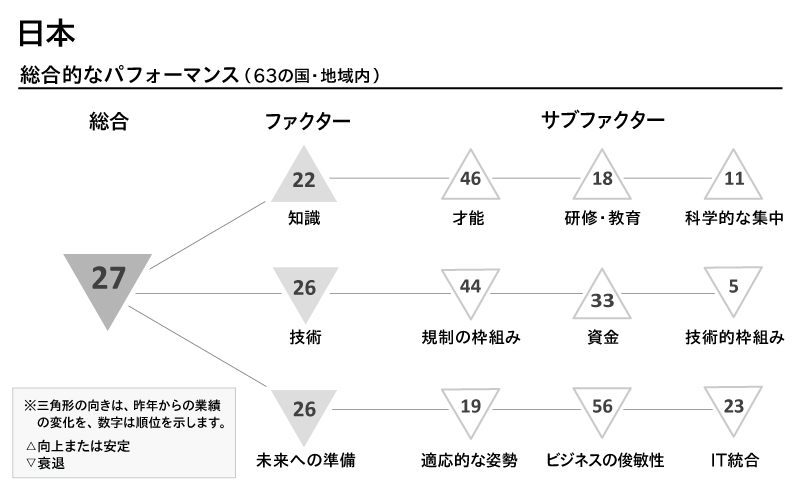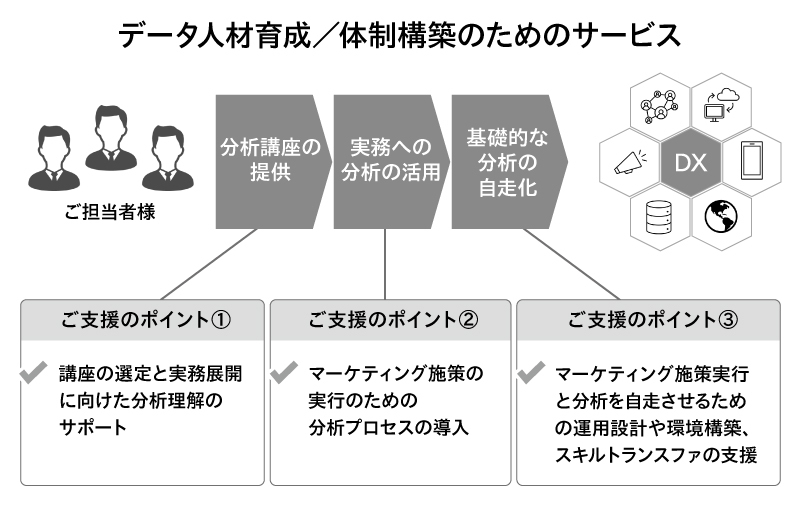Note: This website was automatically translated, so some terms or nuances may not be completely accurate.
Why are American companies able to leverage "data" for business growth?
Japanese companies are said to be failing to fully leverage their vast amounts of data. How can accumulated data be directly linked to significant business growth?
Alongside the proliferation of digital devices like smartphones, companies have sought to acquire and accumulate various data, including audience data, and leverage it for marketing to drive business growth.
Last time, we discussed why these efforts don't always yield significant results in Japan, presented in a dialogue format.
This time, Tadashi Kawabe, CEO of DENTSU CROSS BRAIN INC. and former Director of the Data Scientist Team at Merkle (a leader in data utilization in the U.S.), draws on his experience to introduce the differences in data utilization between Japan and the U.S., along with examples of how American companies utilize data.
<Table of Contents>
▼A Turning Point in Digital Marketing: Enter the Era of "Data Clean Rooms"
▼Is Cultivating Data Talent Alone Insufficient for Japan to Enhance Its Digital Competitiveness?
▼ What's Needed is a "Data Analysis Framework that Supports Marketing Strategy Execution"
A Turning Point in Digital Marketing: Entering the Era of "Data Clean Rooms"
Before discussing the current trend in the US, which is the focus of this article, let's briefly review the current situation in Japan.
Currently, the "Data Clean Room" offered by major platform companies to advertisers is gaining significant attention.
A Data Clean Room is a mechanism allowing advertisers to utilize various information linked to the massive "unique customer IDs" held by platform operators, likened to a virtual room. (Hereafter referred to as Clean Room)
Within this environment, data is anonymized and aggregated. Advertisers can then conduct highly precise targeted advertising within the legal and secure environment provided by the platform. If "purchase data" is linked to the platform's customer IDs, it also becomes possible to verify the impact of ad exposure on customer purchases.
Given the global strengthening of personal information protection and the anticipated future challenges in using third-party cookies for advertising, marketing and communication leveraging clean rooms—which do not rely on third-party cookies—is expected to become increasingly important.
[Editor's Supplementary Explanation]
For those unfamiliar with digital marketing, cookies (HTTP Cookies) are a mechanism for exchanging data between web servers and browsers.
For example, storing login information for a site in a cookie eliminates the need to re-enter it each time. Similarly, saving videos or images loaded once allows them to open much faster on subsequent visits, significantly enhancing internet convenience.
Cookies are tied to "domain names." Cookies linked to the domain of the site currently displayed in the user's browser are called "first-party cookies," while others are called "third-party cookies."
User behavior on the web is stored and accumulated in cookies tied to each domain. Targeting ads, which have long driven the digital advertising market, primarily utilize these third-party cookies.
However, there has been long-standing debate about companies tracking users' online activity histories. In recent years, browser providers like Apple, Google, and Firefox have increasingly moved to restrict the use of third-party cookies for advertising.
Now, let's turn to the situation in the United States.
Even in the U.S., the home turf of the giant platform companies, businesses are actively utilizing clean rooms to manage digital advertising.
The key point is linking the platform's data with the company's own first-party data within the clean room.
First-party data refers to customer information owned by the company itself. This includes customer demographic information, past purchase histories, and website browsing histories, and also encompasses first-party cookies.
By integrating this first-party data into the clean room, companies can identify consumers within the platform ecosystem who share characteristics closer to their existing customers. They can then target these consumers as prospects for their campaigns. By actively adopting this approach, companies are achieving greater campaign efficiency.
Furthermore, some leading American companies are moving to coordinate advertising targeting across multiple different platforms. To do this, they first build a "unique data environment starting from their own first-party data."
They then match this with individual-level data (such as demographic data) provided by external data providers based on user consent. This allows them to accurately build customer profiles and deepen their understanding of customers within their own data environment.
Moreover, unlike a single company's first-party data, the data provided by data providers covers the entire market. This enables companies to identify potential customers within this data who share characteristics similar to their existing customers.
These identified potential customers can be linked at the individual level to the clean rooms provided by each platform. This enables effective advertising campaigns targeting high-potential prospects within each platform's ecosystem. Naturally, since the same potential customers are targeted, performance comparisons across platforms become straightforward.

Furthermore, in the US, advertising segments that group consumers showing explicit interest in specific product categories are also available. By combining these advertising segments with potential customers, efforts are being made to boost advertising effectiveness by delivering ads specifically to those potential customers who are closer to making a purchase.
Moreover, such proprietary data platforms are not solely used for extracting targets for ad delivery.
By cross-referencing diverse data provided by data providers with their own first-party data, it becomes easier to identify segments within existing customers that are "more likely to become repeat buyers" or "well-suited to specific products."
Based on this information, companies optimize email campaigns and communications on their websites.
Major retailers are also widely adopting initiatives to create new revenue streams by offering their data infrastructure as a clean room to other companies and supporting advertising campaigns within their own ad networks.

In Japan, few companies have yet successfully leveraged their own data through clean room partnerships to reach potential customers. However, such initiatives will become essential for future marketing.
Furthermore, to transcend platform barriers and enhance the precision of non-advertising initiatives, building proprietary data infrastructure will become necessary.
Is training data talent alone insufficient for Japan to enhance its digital competitiveness?
Summarizing the discussion so far, the utilization of data in marketing is
- Utilizing data from platform providers' clean rooms for marketing
- Next, linking clean room data with proprietary first-party data to boost effectiveness
- and finally, building your own data environment to enable collaboration across multiple platforms
These steps should be smooth.
One factor enabling U.S. companies to effectively utilize data in this manner is the presence of dedicated teams responsible for collecting and leveraging marketing data.
While the concept of "bringing advertising agencies in-house" is often discussed, particularly among large corporations, American companies are also advancing in-house capabilities in the field of data utilization.
Rather than outsourcing everything to external specialists, they build their own proprietary data accumulation environments and hire and train highly skilled employees to analyze and utilize that data.
They then outsource tasks that cannot be covered by their own resources (talent and data) to external partners.
Against this backdrop, demand for data scientists and data engineers continues to grow in the US.
According to Glassdoor, the employee review service acquired by Recruit in 2018, "Data Scientist" was selected as one of America's Best Jobs consecutively from 2016 to 2019.
Glassdoor's Best Jobs in America is an annual survey and ranking conducted independently by Glassdoor. It quantifies and ranks occupations based on metrics like average annual salary and job satisfaction. This means data scientists have been selected as the Best Job for four consecutive years.
How does this compare to the situation in Japan?
According to the 2020 World Digital Competitiveness Ranking recently released by the Swiss business school IMD, Japan ranked 27th out of 63 countries and regions, dropping four places from the previous year. Factors contributing to this include weaknesses in data analysis and talent acquisition.
We touched on why Japan struggles with data analysis and talent acquisition in our previous discussion.
Meanwhile, the United States, which boasts abundant data analysis talent and high mobility in this field, has maintained its top position for the past three years.

What's needed is a "data analysis framework that supports marketing strategy execution."
So how can Japan as a whole and its companies achieve digital transformation and gain global competitiveness going forward?
This requires more than just cultivating data analysts; it also demands personnel who can apply data analysis to practical marketing operations. Above all, the key lies in establishing an operational framework that connects data analysis to ultimate business growth.
Currently, Japan offers diverse training programs and seminars on data analysis knowledge and skills. Such classroom learning can certainly provide solid knowledge and skills.
However, common challenges frequently heard in the field include the following:
When addressing our company's challenges, we don't even know which training program to take in the first place.
Even after training, understanding the concepts, not knowing how to apply them in practice or how to proceed
This is precisely what could be called a typical challenge for DX in Japan.
Next time, following this discussion on the U.S., we will focus primarily on data analysis in Japan.

Always-On Marketing
Data as the Bridge Between Companies and Customers
DENTSU CROSS BRAIN INC.
https://dxb.co.jp/
DENTSU CROSS BRAIN INC. provides services supporting "talent development" and "system building." Our experts work hand-in-hand with clients to build systems focused on the fundamental goal of "solving marketing challenges."

-
Organizing the necessary skill sets required for problem-solving and selecting the courses needed to acquire them
-
Proposing analytical processes for practical marketing implementation
-
Establishing workflows and environments enabling in-house execution from analysis to implementation
-
Skill transfer from DENTSU CROSS BRAIN INC. personnel to clients
Data isn't something you just collect, nor is it enough to simply have data analysts. What's needed is "building a data analysis framework within marketing."
If you're facing challenges, please consult DENTSU CROSS BRAIN INC.
Contact DENTSU CROSS BRAIN INC. here
https://dxb.co.jp/contact/
Was this article helpful?
Newsletter registration is here
We select and publish important news every day
For inquiries about this article
Back Numbers
Author

Tadashi Kawabe
DENTSU CROSS BRAIN INC.
President and CEO
Master of Engineering, University of Tokyo; MBA, MIT. For approximately 10 years, engaged in communication strategy/initiative planning based on data analysis, driving PDCA cycles, operating marketing tools, data acquisition/visualization, and environment building. Subsequently, participated in projects including organizational reform and M&A within the Dentsu Group planning division, then seconded to Merkle, Inc. in the U.S. until August 2020. As Director of the Data Science team, he was involved in planning advertising/email campaigns utilizing PII and conducting effectiveness verification.


